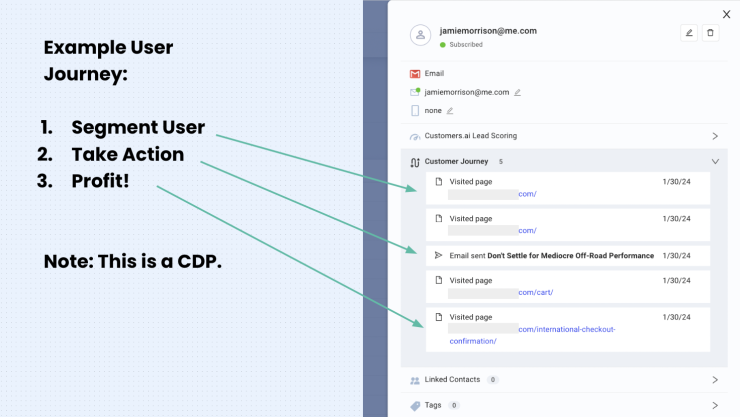Businesses are striving to deliver a seamless omnichannel experience that transcends individual channels. The goal?
To craft a unified brand narrative that resonates with customers wherever they interact – be it your website, social media, email campaigns, or brick-and-mortar stores.
At the core of this omnichannel approach lies website visitor identification – a powerful tool empowering marketers to gain deeper insights into their audience’s behavior and preferences. By unmasking individuals behind website visits, businesses unlock opportunities to personalize marketing efforts and forge stronger connections.
Demystifying Website Visitor Identification
Website visitor identification associates anonymous website traffic with real individuals or companies.
This is typically achieved through techniques like IP address tracking, cookie matching, or integrating with third-party data providers.
Its beauty lies in bridging the digital and physical worlds by tying online behaviors to identities, creating a comprehensive view of customers’ journeys across touchpoints.

Imagine a potential customer visits your website, browses products, then leaves without purchasing. With visitor identification, you capture their digital footprint, match it to contact information, and follow up with a personalized email or retargeting campaign tailored to their interests.
The Omnichannel Marketing Advantage
Implementing website visitor identification can supercharge omnichannel marketing efforts:
-
Personalized Experiences: Tailor messaging, offers, and content to individuals based on browsing behavior, purchase history, and demographics. This personalization fosters stronger connections and improves conversions.
-
Seamless Transitions: Recognize customers across channels, ensuring a consistent, cohesive experience as they move between touchpoints, eliminating frustration.
-
Targeted Campaigns: Leverage detailed customer insights to segment audiences based on interests, behaviors, and lifecycle stages, delivering highly relevant campaigns that resonate.
-
Attribution and Analysis: Gain clarity on customer journeys, attributing conversions to specific touchpoints and optimizing marketing strategies accordingly.
Unleashing the Power of Data
At its core, website visitor identification harnesses the power of data to unlock a deeper understanding of your audience. By capturing and analyzing rich customer data, you can uncover valuable insights that inform your marketing strategies.
For instance, you might discover that a significant portion of your website visitors are interested in a particular product category, prompting you to create targeted content and campaigns tailored to that interest. Or, you may identify patterns in how customers navigate your website, allowing you to optimize the user experience and remove friction points.
Furthermore, integrating website visitor identification with other data sources, such as CRM systems or third-party data providers, can paint an even more comprehensive picture of your customers.
This holistic view enables you to deliver truly personalized experiences that resonate on a deeper level.
Building Trust and Loyalty
While the power of website visitor identification is undeniable, it’s crucial to approach it with transparency and respect for customer privacy. Clearly communicate your data collection practices and provide options for customers to opt-out if desired.
By fostering trust and demonstrating a commitment to ethical data usage, you can strengthen customer loyalty and build lasting relationships.
In the realm of omnichannel marketing, website visitor identification is a game-changer.
It empowers businesses to break down silos, gain a comprehensive understanding of their audience, and deliver personalized, cohesive experiences that resonate across every touchpoint.
By harnessing the power of data and embracing this powerful tool, businesses can unlock new levels of engagement, conversions, and customer loyalty.
FAQs
-
How does visitor identification benefit omnichannel marketing?
Visitor identification enables businesses to deliver personalized experiences, ensure seamless transitions across channels, run targeted campaigns, and gain insights into customer journeys for optimized marketing strategies. -
What techniques are used for website visitor identification?
Common techniques include IP address tracking, cookie matching, and integrating with third-party data providers that can match online behaviors to real identities. -
Can visitor identification improve conversion rates?
Yes, by personalizing messaging, offers, and content based on visitor behavior and data, businesses can create more relevant and engaging experiences, leading to improved conversion rates. -
How does visitor identification facilitate personalization?
With visitor identification, businesses can tailor their marketing efforts to specific individuals based on their browsing behavior, purchase history, and demographic data, enabling highly personalized experiences. -
What role does visitor identification play in customer segmentation?
By associating online behaviors with real identities, businesses can segment their audience based on interests, behaviors, and lifecycle stages, allowing for targeted campaigns that resonate with specific groups. -
How does visitor identification support attribution and analysis?
Visitor identification provides a clearer picture of the customer journey, enabling businesses to attribute conversions to specific touchpoints and optimize their marketing strategies accordingly. -
Can visitor identification improve customer loyalty?
Yes, by recognizing customers across channels and delivering consistent, cohesive experiences, businesses can foster stronger connections and improve customer loyalty. -
What are the privacy considerations with website visitor identification?
Businesses must ensure they comply with data privacy regulations and obtain proper consent when collecting and using personal data for visitor identification purposes. -
How can businesses implement website visitor identification?
Implementing visitor identification typically involves integrating with third-party data providers, setting up IP tracking or cookie matching, and ensuring proper data management and privacy compliance.

